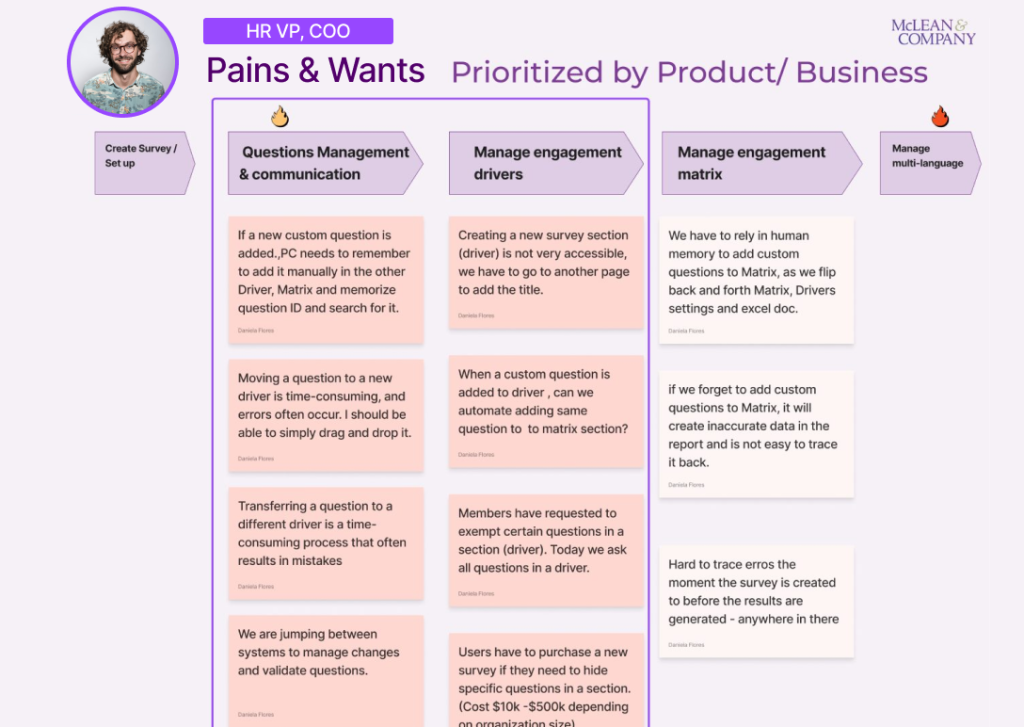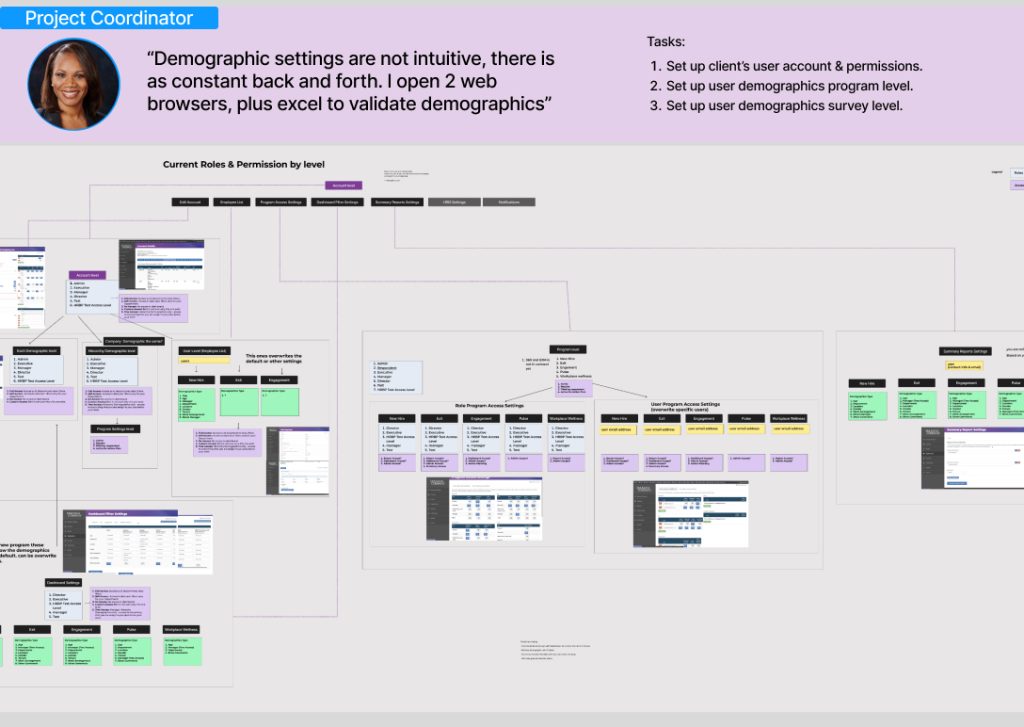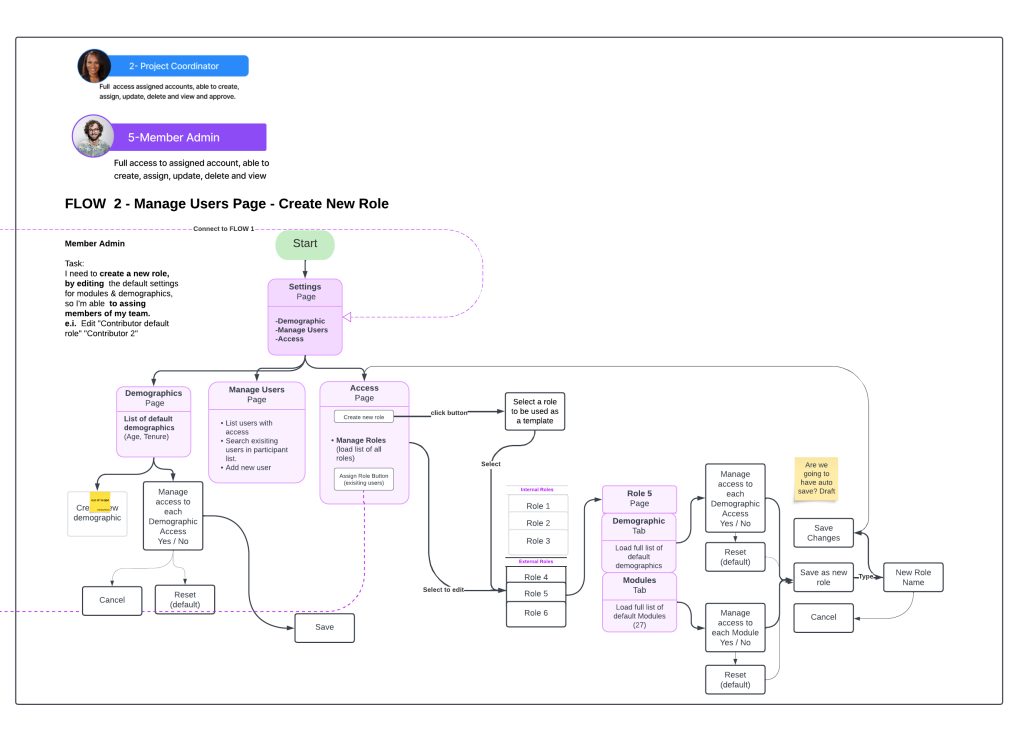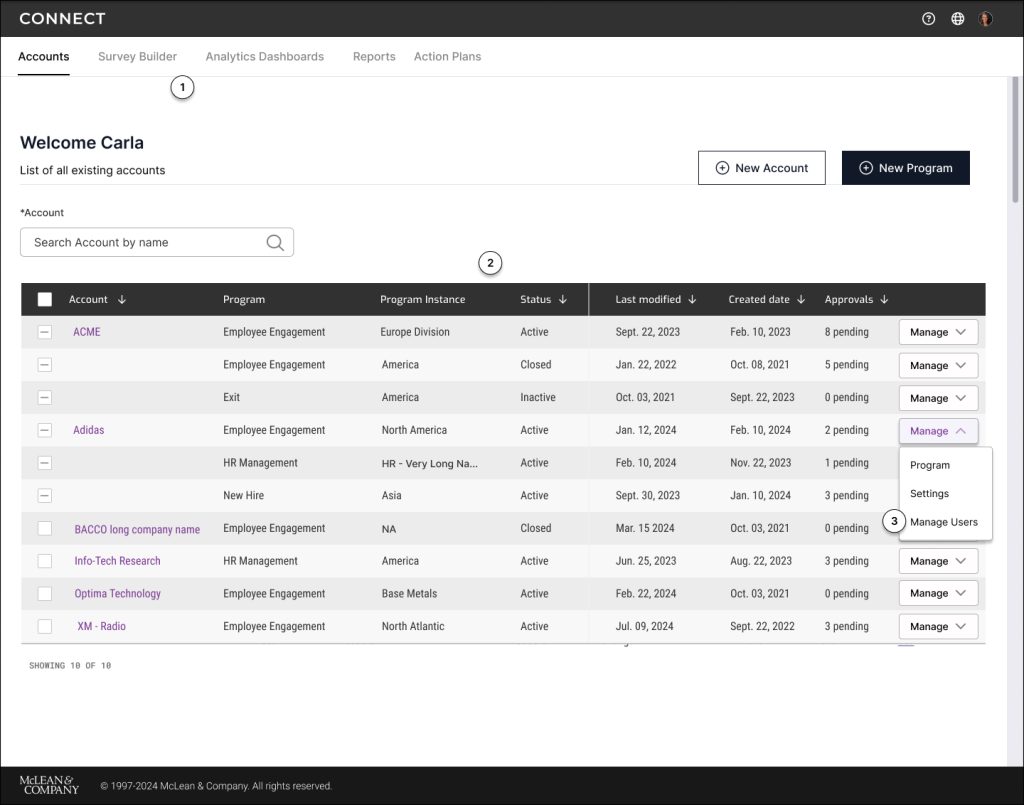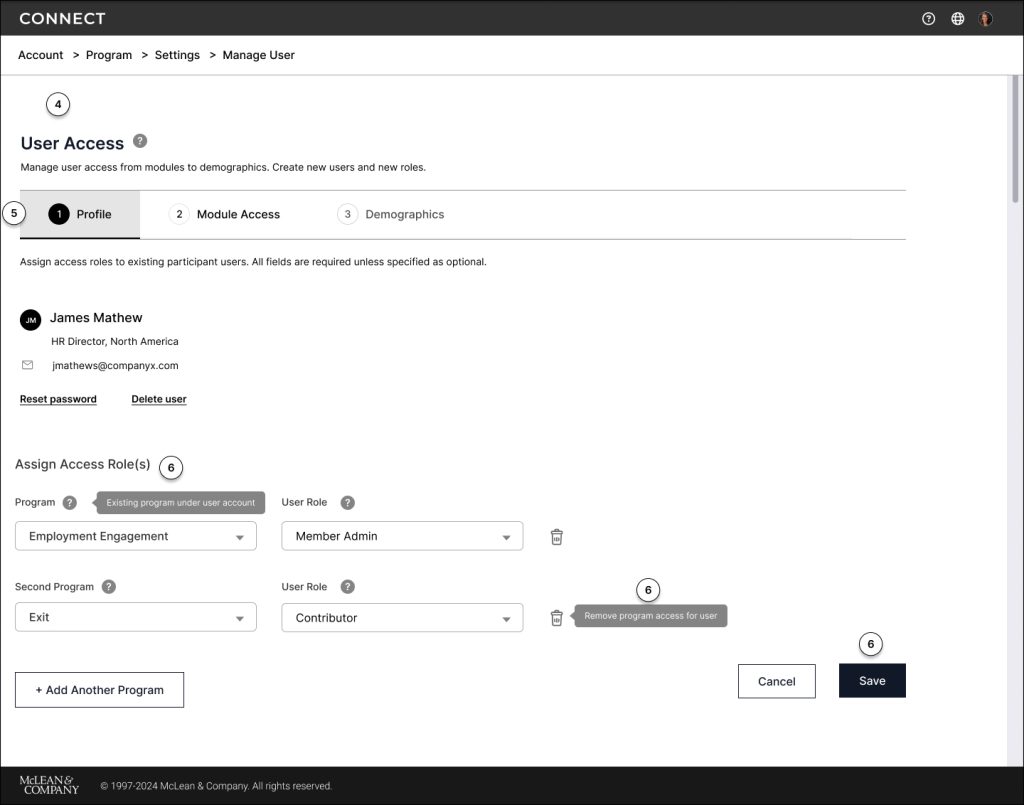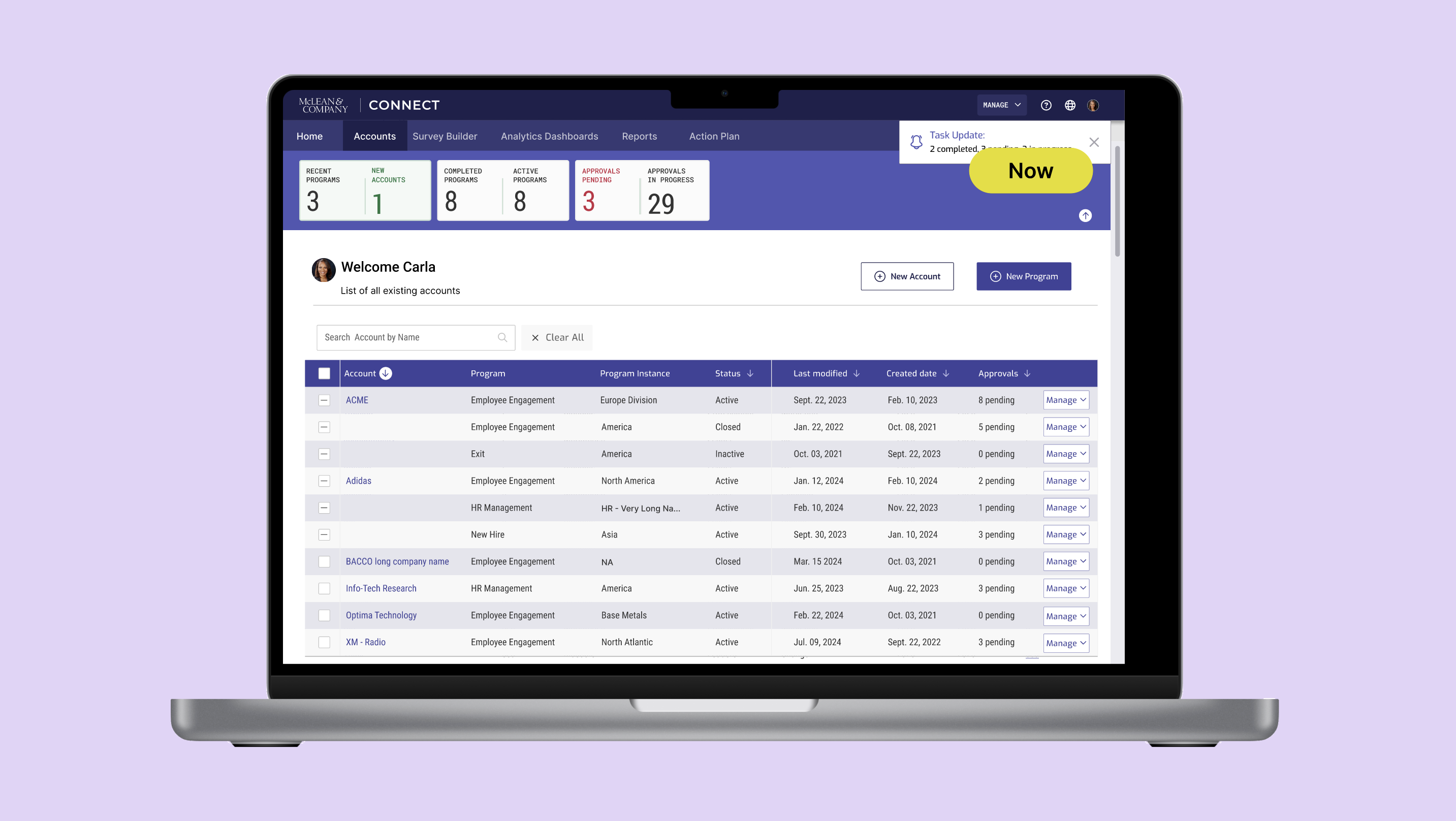Cutting management time by simplifying roles and permissions for a diagnostic app.


B2B / B2C | Information Architecture | Journey Mapping | Product Vision & Strategy | Stakeholder Engagement | User Research | Design | Workshop Facilitation
Product
Connect App
Project Goal
Streamlining user roles & permissions to reduce project management time.
Client
McLean & Company offers diagnostic tools, frameworks and consulting.
Primary end user
Project Coordinator (staff)
My role
Lead UX Designer
Team
Product Manager, Stakeholders, Lead Developer, Architect, UX & UI Design team.
Timeline
6 months
Secondary end user
HR professional & C-Suit members(client)
Outcomes
↓ 37% Reduction in staff management time.
↓ Decrease in data privacy risk.
↓ 33% Reduction in training time for new project coordinators.
Context
The Connect app needed a major revamp to fix messy user permissions and reduce management time.
What’s Connect?
Connect is a smart survey platform that helps organizations run surveys and gather employee feedback easily. It turns raw data into actionable insights, making it easier for HR professionals to spot areas for improvement and boost workforce engagement.
The Problem
The Connect diagnostics app faced significant hurdles, including :
- User permissions were managed across multiple locations.
- Clients and peers relied heavily on coordinators (staff) due to limited roles and permissions.
- Coordinators often had to impersonate users, raising compliance and data privacy concerns.
- Clients lacked visibility and autonomy, which prevented them from delegating work to their teams.
IMPACT
Clients have the autonomy to manage their team roles and permissions, which has cut project management time significantly at every stage of the survey journey.
Key User Outcomes:

Project Coordinator
Internal user (staff)
- Create various roles for client and their teams.
- Access a centralized location to manage roles and permissions.
- Save time by assigning administrative tasks to clients and their teams.
- Eliminate the risk of impersonating clients by granting them full autonomy to manage their data.
- Minimize reliance on peers by assigning read-only permissions for independent access to information.

Member Admin External User (client)
- Collaborate openly with their team and stakeholders while building surveys and developing analytics and action plans.
- Delegate tasks to team members without concerns about data privacy.
- Administer and access their data at any time, ensuring flexibility and control.
Quality Impact:
Reduction
Management Time
Clients now have the autonomy to manage their team roles and permissions, leading to a significant reduction in project management time at every stage of the survey journey.
Decreased
Data Privacy Risk
Coordinators frequently had to impersonate users, which posed a privacy risk. By giving clients full autonomy, we have minimized this risk and improved compliance.
Quantity Impact:
33%
Reduction
Training time for new project coordinators (PC) is projected to decrease from 6 months to 2 months.
5 hrs.
Saving
Time spent by PC managing client participant data is expected to drop from 8 hours to 3 hours.
1 hr
Saving
Time spent by PC on copying and pasting translations for a single language is anticipated to decrease. With 11 translations, this could result in a total time savings of 11 hours.
Process
Project Phases & Frameworks
Research & Discovery →
- Review existing research and find gaps.
- Journey Map and demos.
- Architecture audit.
- Interface accessibility evaluation.
- Hotjar recording analysis.
- Stakeholder Presentation
Defining & Integration →
- Double diamond and product strategy alignment.
- OKRs benchmark.
- Back-end integrated architecture.
- Roles & permissions matrix.
- Stakeholder Presentation
Prototype &
Test →
- Flow diagraming & user story documentation.
- Wireframing
- Testing
- Stakeholder Presentation
Implement & Handoff →
- Feedback adjustment.
- Handoff to the design team.
- Final report presentation for stakeholder engagement.
To tackle these issues, I kicked things off with product vision workshops to align with stakeholders and secure their support for a clear roadmap to our MVP 1.
RESEARCH & DEFINING
Mapping the journey from running a survey to HR strategy
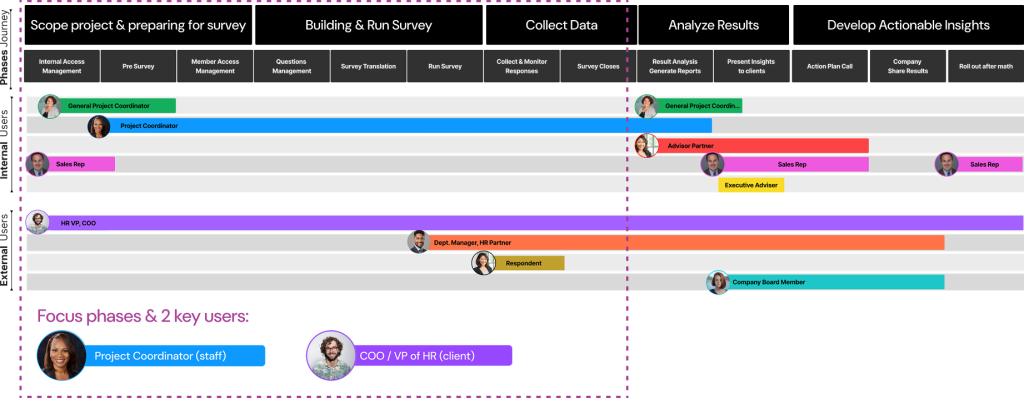
After analyzing quantitative and qualitative data, I identified gaps and ran journey mapping sessions, interviews, demos and sales calls.
I collaborated with Tech to integrate a back-end architecture supporting a new roles-and-permissions system — auditing and mapping data systems, creating a role-based access control matrix with self-serve roles for seven user types, and building user flows (jobs-to-be-done). I evaluated interface accessibility, tested wireframes with key users, and kept stakeholders engaged through regular presentations.
Solution
Granting access to peers and clients in 1 place.

Project Coordinator
Internal user (staff)
With clients taking charge of their teams and data, project coordinators can kiss those long management hours goodbye! This shift not only frees up their time but also empowers clients to handle their sensitive data independently and confidently. It’s a win-win!
Improvements:
① Home Shortcut – Quick access to the “Manage Users” page.
② Manage User Page – A one-stop shop for user creation and edits.
③ User Search – finding an existing user among hundreds of participant users.
④ Custom User Roles – Create new user roles specifically tailored to each client or program.
⑤ Role Type Tooltips – Clear descriptions for each role type.
⑥ Flexible Permissions – Adjust roles and permissions anytime.
⑧ Client Notifications – Clients are automatically notified of new access.

Member Admin External User (client)
Clients can collaborate openly with their teams and stakeholders while building surveys and developing analytics and action plans. They can delegate tasks to team members without worrying about data privacy, and they have the freedom to access and manage their data anytime, ensuring they stay in control!
SOLUTION
The new workflow makes it easier to create different roles
and helps users (staff and clients) navigate the tricky bits of
managing complex permissions and demographics.
Clients now have the freedom to manage their team roles and permissions, as well as upload their participant lists—all of which cuts our workload from days to just a few hours! Talk about a game changer!”
April Ridsdale
Senior Director, HR Diagnostics Leadership
